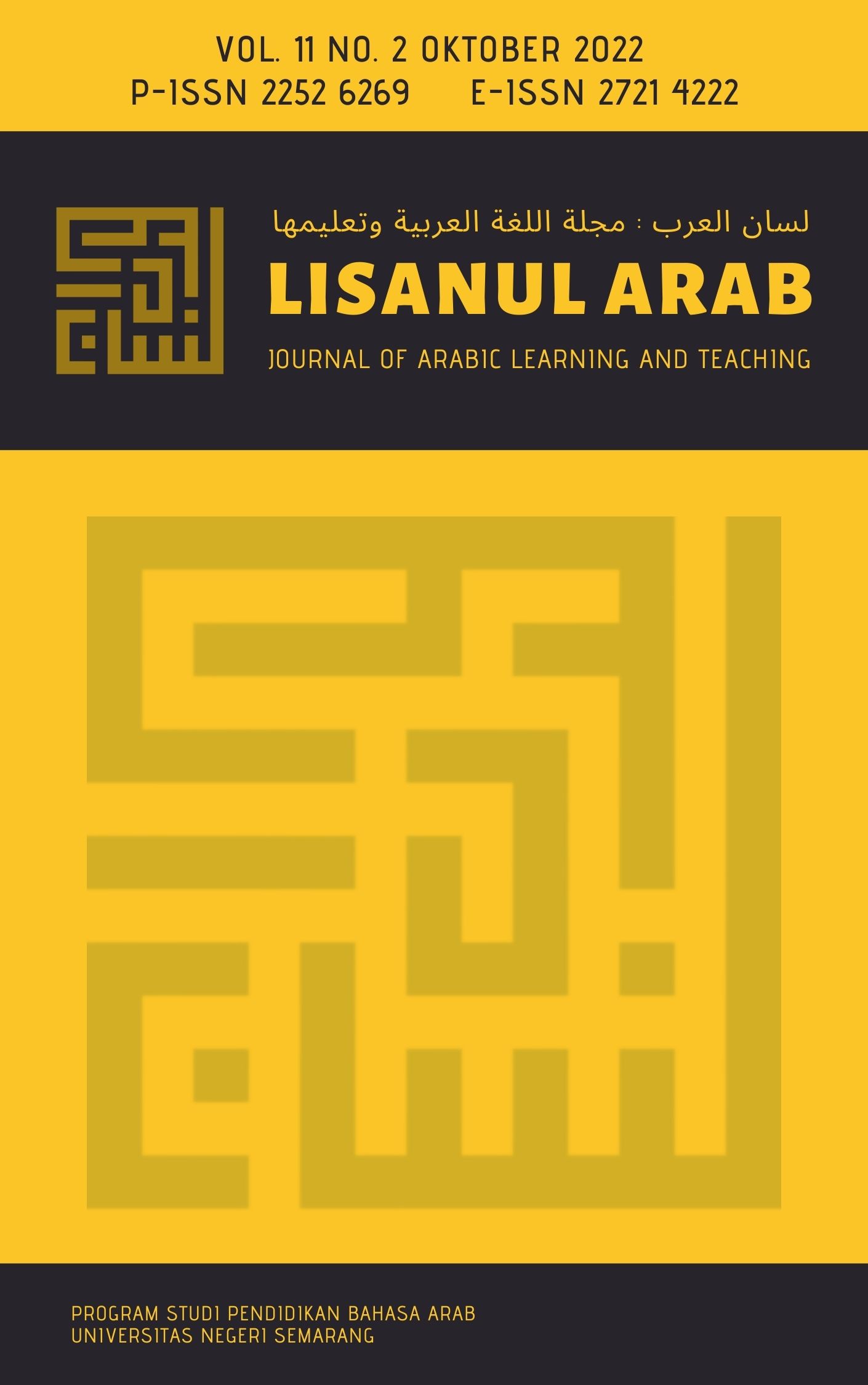ISTIKHDAM AL-TA’ALLUM AL-ILIKTRUNIY LI TA’LIM AL-LUGHAH AL-ARABIYAH FI MADRASAH AL-TSANAWIYAH AL-HUKUMIYAH 1 KERINCI The Use Of E-Learning for Arabic Teaching At MAN 1 Kerinci Section Articles
##plugins.themes.academic_pro.article.main##
Abstract
This study aims to explore the use of e-learning in teaching Arabic, the model of e-learning application used in teaching Arabic, and the supporting and inhibiting factors in implementing e-learning in teaching Arabic in MAN 1 Kerinci. This study is a field study. The data sources are head school, Arabic language teacher, and students. The other data source is documents related to e-learning for teaching Arabic in MAN 1 Kerinci. The methods used to collect data are observation, interview, and documentation. The technics used to collect data are information reduction, data presentation, and verification of conclusions. To correct the data, the researcher used the triangulation technique. The results for this study are; 1) E-learning in Arabic language education is not ready in MAN 1 Kerinci for implementation due to several factors, 2) Teaching Arabic using WhatsApp application with WhatsApp group feature. The network of communication that occurs between teacher and students in this feature tends to be non-communicative. 3) It supports the use of e-learning in learning Arabic for the reason of several factors; a) the policy of the socialization contract from the government to implement e-learning in learning during the pandemic, b) optimism from the administration and teachers to be able to Adapt quickly to the use of e-learning. Disincentives to using e-learning in Arabic language learning include; a) teacher and students do not have the opportunity to meet and interact directly, b) lack of facilities in the form of e-learning facilities from both teacher and students, c) the deadline is too short, while students still need time to understand learning material, d) parents cannot continue to escort, e) unstable internet.
##plugins.themes.academic_pro.article.details##
References
Asdari, A., Nisa’, M., Hady, Y., Wadud, A., & Anwar, K. (2022). Optimalisasi Pembelajaran Bahasa Arab di Masa Covid-19 Melalui E-Learning pada Prodi Non Bahasa Arab. Arabi : Journal of Arabic Studies, 7(1), 93–108. https://doi.org/10.24865/AJAS.V7I1.457
Iswanto, R. (2017). Pembelajaran Bahasa Arab dengan Pemanfaatan Teknologi. Arabiyatuna : Jurnal Bahasa Arab, 1(2), 139. https://doi.org/10.29240/jba.v1i2.286
Jasni, N. S. B., & Ardiansyah, A. A. (2020). Arabic Learning Based On E-Learning Using Arabic Teacher Website In The Pandemic Era Of Covid-19. Ta’lim Al-’Arabiyyah: Jurnal Pendidikan Bahasa Arab & Kebahasaaraban, 4(2), 122–137. https://doi.org/10.15575/JPBA.V4I2.8601
Miolo, M. I., & Djafar, S. (2022). Implementing E-Learning on arabic Language Subject During Covid 19 Pandemic in Madrasah Aliyah Negeri 1 Boalemo. Journal.Umgo.Ac.Id, 11(1), 192–205. https://doi.org/10.31314/ajamiy.11.1.192-205.2022
Ritonga, A. W., Zulfida, S., Ritonga, M., Ardinal, E., & Susanti, D. (2021). The Use of E-learning as an Online Based Arabic Learning Media for Students. Journal of Physics: Conference Series, 1933(1), 012127. https://doi.org/10.1088/1742-6596/1933/1/012127
Rozi, F., Putri, M. W., & Wijaya, M. R. A. (2021). E-Learning System For Physical Education In IAIN Salatiga Using Google Classroom. EDUKATIF : JURNAL ILMU PENDIDIKAN, 3(2), 270–277. https://doi.org/10.31004/edukatif.v3i2.268
Saefuloh, H., & Aflisia, N. (2022). Konvergensi Separated dan All in One System dalam Pembelajaran Bahasa Arab di Pondok Pesantren al-Muqaddas Cirebon. Arabia: Jurnal Pendidikan Bahasa Arab, 14(1), 17–38. https://doi.org/10.21043/ARABIA.V14I1.13581
Silahuddin, S., & Azhari, A. (2019). Inovasi Media Pembelajaran Bahasa Berbasis E-Learning pada Sekolah. CIRCUIT: Jurnal Ilmiah Pendidikan Teknik Elektro, 3(1), 40. https://doi.org/10.22373/crc.v3i1.4426
Wijoyo, T. (2016). Pengembangan Media Pembelajaran E-Learning Berbasis Aplikasi Lectora Inspire untuk Keterampilan Membaca Bahasa Arab Siswa MTS Kelas VIII. Lisanul’ Arab: Journal of Arabic Learning and Teaching, 5(1), 5–10.
Yul, W., & Aflisia, N. (2022). Takwin Al-Biah Al-Lughawiyyah fi Ma’had Nurul Haq Semurup Kerinci. Ihya Al-Arabiyah: Jurnal Pendidikan Bahasa Dan Sastra Arab, 8(1), 28–44. https://doi.org/10.30821/IHYA.V8I1.12236
